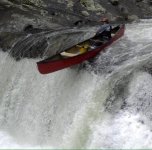Here is a three-part video on solo whitewater technique by Tom Foster, who was the chief of all paddling instruction for the ACA for many years, headed the Outdoor Center of New England, wrote paddling books, raced whitewater slalom, co-designed the Mad River Outrage and Outrage X, sold and custom outfitted canoes, and taught paddling for decades. I believe this set of videos was taken from his popular DVD called Catch Every Eddy—Surf Every Wave.
You will notice basic things about his technique right away before you can execute any of the river maneuvers properly.
1. You must be centralized in the canoe, not just for trim, but because all on-side and off-side forward strokes are initiated and completed in the bow quadrants.
2. You must have an instinctive and effective cross-forward stroke.
3. You must be comfortable J-leaning your canoe to both sides, preferably right down to the gunwales.
4. You must learn to initiate and maintain a carving arc because you will always be paddling in a circle of some diameter, even when going "straight".
These videos are long and may not be for everyone, but if you can master what Tom teaches, you can become a confident and advanced level solo canoeist. (For some reason, you may have to roll the videos back to the beginning.)
You will notice basic things about his technique right away before you can execute any of the river maneuvers properly.
1. You must be centralized in the canoe, not just for trim, but because all on-side and off-side forward strokes are initiated and completed in the bow quadrants.
2. You must have an instinctive and effective cross-forward stroke.
3. You must be comfortable J-leaning your canoe to both sides, preferably right down to the gunwales.
4. You must learn to initiate and maintain a carving arc because you will always be paddling in a circle of some diameter, even when going "straight".
These videos are long and may not be for everyone, but if you can master what Tom teaches, you can become a confident and advanced level solo canoeist. (For some reason, you may have to roll the videos back to the beginning.)

